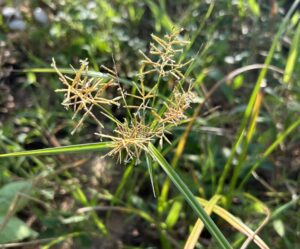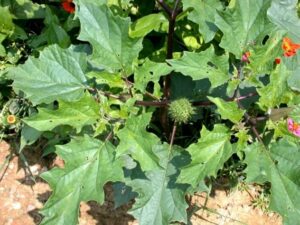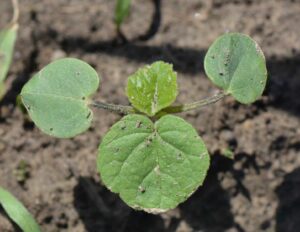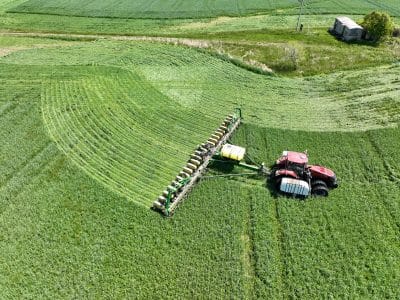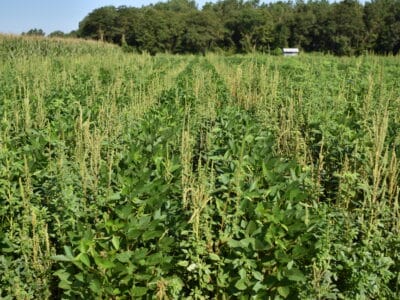Sicyos angulatus L.
Also known as wild pickle, pickle, wild cucumber
Note: This information is based on experience in the Mid-Atlantic states; recommendations in other regions may vary.
Burcucumber is a summer annual broadleaf weed that is a serious problem in agronomic crops in some regions of the Northeast. Because of its prolonged seedling emergence and aggressive growth habit, burcucumber is not easily controlled using conventional weed management strategies. Like most weeds, burcucumber cannot be eradicated; however, an integrated control approach can reduce the size of burcucumber infestations and slow or stop the weed’s further spread
Identifying Features
Burcucumber can be identified by its pentagon-shaped leaves, long vines (up to 25 feet), and spiny seed clusters. The individual seeds are flattened, have a hard seed coat about the size of a watermelon seed, and are enclosed in a prickly, fleshy shell, or pericarp. The hard seed coat contributes to the burcumber’s prolonged seed dormancy, which means that fields currently infested with burcucumber will have a lasting seed reservoir in the soil and the potential for a burcucumber problem for many years.
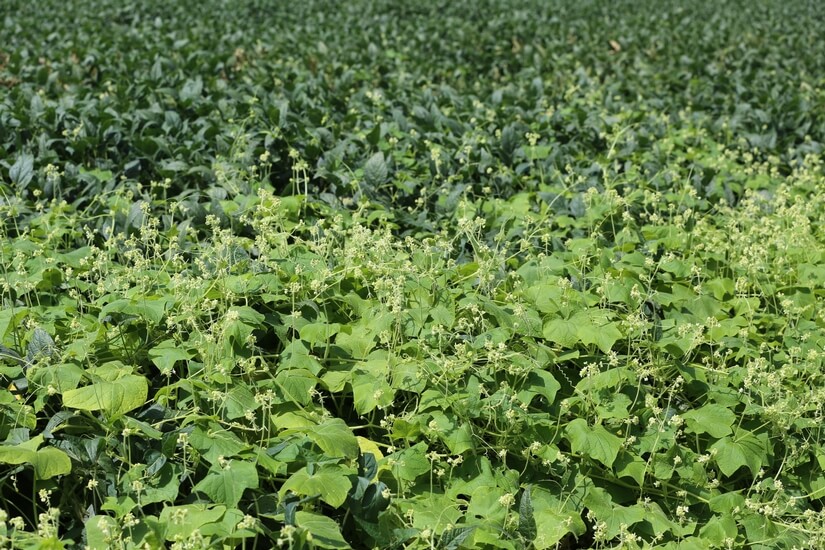
Seed Production
A single plant can produce up to 4500 seeds. Seedling emergence occurs throughout much of the summer. Seeds have hard thick seed coats that contribute to seed longevity. Scarification improves germination and seedlings emerge readily up to 4.5 inches deep
Herbicide-Resistance
None reported.
Management
The first step is to prevent burcucumber seed spread by thoroughly cleaning tillage and harvesting equipment before leaving infested fields. Encourage aggressive crop growth through good cultural practices such as maintaining adequate soil fertility, choosing appropriate high-yielding crop varieties, and regularly scouting for and managing pests. Include in the rotation crops that provide early competition such as alfalfa or small grains. Include no-till in fields that are infested with burcucumber. Research suggests that no-till allows burcucumber seed to remain near the soil surface, thus allowing germination to occur over a shorter time period and reducing the number of germination flushes. This also improves herbicide effectiveness and performance. Harvest burcucumber-infested fields for silage to prevent viable seed production.
Corn
Herbicides are essential in a burcucumber management program but use them in combination with other control methods. Several corn herbicides provide good control of burcucumber and they are most effective on young seedlings rather than larger plants. Include herbicides that have residual activity to control new burcucumber flushes. POST (foliar-applied) herbicides provide the best burcucumber control. In corn, if possible, include at least 1.5 pounds of atrazine in the herbicide program for residual control. Other effective herbicides include prosulfuron (Peak), mesotrione (Callisto), and glyphosate. In addition, other Group 6 herbicides such as bromoxynil are effective for controlling emerged plants.
Sorghum
Management of burcucumber in sorghum should be similar to corn and relies on POST herbicides. Some of the same herbicides, except glyphosate, can be used in sorghum.
Soybean
Burcucumber may be easier to manage in soybean than in corn simply because you can better monitor control and apply herbicides later in soybean than in corn. The most effective herbicides for control in soybean are glyphosate plus a residual product like chlorimuron. More than one foliar application may be necessary.
Small Grains
Burcucumber is only an issue in spring-seeded small grains and generally not winter grains, so it could be problematic in oats or other spring-seeded cereals. Seed spring grains as early as possible to get a head-start on the burcucumber. Some suppression can be obtained from the Group 2 or ALS herbicides or Group 6 or 14 contact-type herbicides.
Perennial Forages
Perennial forages are an excellent crop for managing burcucumber. In particular, established alfalfa that can be mowed four or more times per season will suppress burcucumber seedlings and it is rarely a problem in these crops. Establish alfalfa in late summer to avoid burcucumber problems at establishment. Burcucumber is rarely a problem in perennial grass hay or pasture.
Fallow or Spot Treatment
Spot spray with glyphosate or paraquat or use Group 4 growth regulator herbicides.
This content was presented in the “Mid-Atlantic Field Crop Weed Management Guide” (2020), Penn State Ag Communications, AGRS-136

